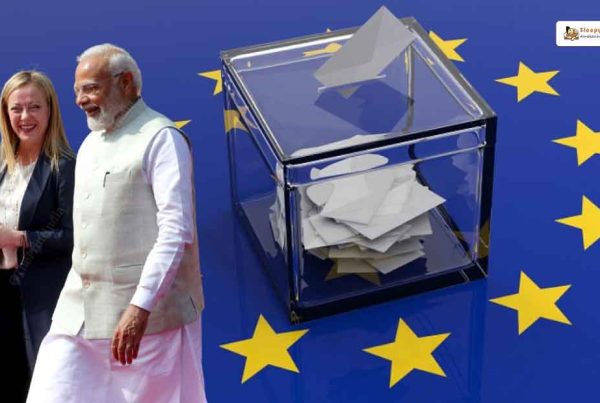India’s diplomatic scene in 2025 is like a chess game, full of strategic moves and unexpected turns. With the world changing fast, India’s got to juggle a bunch of challenges and opportunities. From dealing with tricky neighbors to making sure its energy supplies are secure, India is trying to stay ahead. It’s all about finding the right balance between keeping old friends and making new ones, while also looking after its own interests. The country’s got its hands full, but with the right moves, it could come out on top.
Key Takeaways
- India’s diplomatic efforts are crucial in managing regional and global conflicts.
- Energy security remains a major concern, with a focus on low-carbon solutions.
- Economic diplomacy is key to strengthening trade relations worldwide.
- Technological advancements present both opportunities and challenges for India.
- Defense strategies are evolving to address new security threats.
India’s Diplomatic Landscape in 2025
Evolving Geopolitical Dynamics
In 2025, India finds itself amid a rapidly changing global scene. The return of Donald Trump to the U.S. presidency, along with shifting alliances in Europe, presents both opportunities and challenges. India must navigate these waters carefully, maintaining its traditional stance of non-alignment while engaging with emerging powers. Balancing these dynamics is crucial for India’s strategic positioning.
India’s Role in Global Conflicts
India’s approach to global conflicts, like the ongoing tensions in Ukraine and the Middle East, remains one of cautious diplomacy. New Delhi aims to mediate where possible, leveraging its relationships with both Western powers and countries like Russia and China. This role not only enhances India’s global standing but also tests its diplomatic agility.
Strategic Partnerships and Alliances
Building on its past successes, India continues to forge strategic partnerships across the globe. Its ties with the United States are expected to deepen, especially in areas like defense and technology. Meanwhile, India is also looking to strengthen its relationships with African nations and Latin America, ensuring a diversified diplomatic portfolio. The focus remains on creating alliances that bolster India’s global influence while safeguarding its national interests.
In an era of shifting alliances and rising tensions, India’s diplomatic strategy must be both adaptive and resolute. The nation’s ability to maintain its sovereignty while engaging with global powers will define its success on the world stage.
Challenges in India’s Neighborhood Diplomacy
Political Changes in South Asia
India’s neighborhood is experiencing significant political shifts, with Bangladesh and Nepal leading the charge. In Bangladesh, the political landscape is evolving as the country strengthens its ties with China and Pakistan, potentially sidelining India. Nepal, on the other hand, continues to lean towards China, with pro-China policies gaining traction. These changes pose a serious challenge to India’s influence in the region.
Managing Relations with China and Pakistan
Relations with China and Pakistan remain tense. While border talks with China show some promise, the trust deficit is still a major hurdle. Pakistan, meanwhile, is a different story. Diplomatic ties are practically frozen due to ongoing concerns about terrorism and Kashmir. India needs to tread carefully, balancing firmness with diplomatic engagement.
Regional Stability and Security Concerns
Regional stability is a constant concern for India. The rise of anti-India sentiments in neighboring countries like the Maldives complicates matters. Security concerns are heightened by the presence of Chinese-backed infrastructure projects in these regions, which could potentially threaten India’s strategic interests. India must bolster its diplomatic and economic engagements to counter these challenges effectively.
India’s Energy Security and Geopolitical Implications
Transition to Low-Carbon Energy
India is on a path to transform its energy landscape by embracing low-carbon solutions. This shift, however, is fraught with hurdles like technology gaps, high costs, and limited land for renewable projects. India’s ambition to become a leader in renewable energy is bold, but the road is bumpy. The country needs innovations in hydrogen and carbon capture technologies, which are still in their infancy. Moreover, there’s a pressing need to secure raw materials crucial for these technologies. A comprehensive strategy that includes clean coal and nuclear power alongside renewables is essential to meet energy demands sustainably.
Geopolitical Risks in Energy Supply Chains
The global energy market is a maze of geopolitical tensions, especially with unresolved conflicts in Europe and the Middle East. These tensions pose risks to energy security, making it vital for India to diversify its energy sources. The reliance on imported oil and gas exposes the economy to price shocks and supply disruptions. To mitigate these risks, India must strengthen its strategic petroleum reserves and explore alternative energy corridors, such as the International North-South Transport Corridor.
Strategic Energy Partnerships
Strengthening energy ties is a cornerstone of India’s strategy to ensure energy security. Collaborations with countries like the U.S., Russia, and Middle Eastern nations are pivotal. These partnerships are not just about securing energy supplies but also about technology exchange and investment in energy infrastructure. As Union Minister Hardeep Singh Puri highlighted, enhancing India’s energy security is crucial for economic growth, aiming for a USD 4 trillion economy by 2027. By fostering these alliances, India can navigate the complex geopolitics of energy and maintain a stable supply chain.
India’s journey towards energy security is not just about reducing carbon footprints but also about navigating a complex geopolitical landscape. Balancing domestic needs with international relations will define its success.
Economic Diplomacy and Trade Relations
India’s Trade Strategy with the West
India’s trade strategy with Western nations is a balancing act, especially as it navigates the complexities of global politics. With Trump’s trade policies casting a shadow, India is keenly aware of the need to diversify its supply chains. The Production-Linked Incentives (PLI) scheme is one way India is enhancing its geoeconomic strategy, aiming to boost domestic manufacturing and reduce dependency on imports. Strengthening ties with the US and EU remains pivotal, yet challenges like tariffs and market access persist.
Opportunities in Africa and Latin America
Africa and Latin America offer untapped potential for India’s economic diplomacy. As Western markets face saturation, these regions provide new avenues for growth. India is looking to capitalize on its historical ties and shared developmental goals with African nations. In Latin America, sectors like pharmaceuticals and technology present significant opportunities. India aims to establish stronger trade agreements and investment partnerships to foster mutual growth.
Balancing Trade with China and Russia
The economic relationship with China is a tightrope walk. Despite border tensions, bilateral trade remains considerable, but India is wary of its trade deficit, particularly in electronics and pharmaceuticals. The “China+1” strategy is gaining traction, encouraging businesses to look beyond China for manufacturing. Meanwhile, India’s relationship with Russia is shaped by energy needs and defense cooperation. The discounted oil imports from Russia are vital, yet India’s strategic calculus must consider Russia’s growing ties with China.
India’s Strategic Autonomy and Non-Alignment
Modern Non-Alignment Policy
In 2025, India continues to embrace its historical policy of non-alignment, but with a modern twist. The nation strives to maintain its strategic autonomy by not binding itself to any single global power. This approach allows India to engage with multiple countries, fostering diverse partnerships while avoiding entanglement in rigid alliances. With the world witnessing a shift towards a quasi-multipolar order, India’s policy of non-alignment is more relevant than ever, enabling it to navigate complex international waters without compromising its independence.
Balancing Global Power Relations
India’s foreign policy is a delicate balancing act. It must maintain positive relations with major powers like the United States, China, and Russia, each with its own set of challenges and opportunities. India’s ability to engage with these powers without appearing to take sides is crucial. This balancing act is not just about diplomacy; it’s also about leveraging economic ties, defense collaborations, and cultural exchanges to strengthen its position globally.
India’s Role in Multilateral Organizations
India’s participation in multilateral organizations like the United Nations, BRICS, and the G20 is pivotal in asserting its presence on the global stage. These platforms provide India with opportunities to voice its perspectives on key international issues, from climate change to global security. Through active engagement, India aims to influence global policies and contribute to a more balanced world order. By championing initiatives that align with its interests, India seeks to enhance its standing as a responsible global player.
Technological Advancements and Geopolitical Challenges
India’s Digital Diplomacy
In 2025, India’s digital diplomacy is all about using tech to build global partnerships. The country’s focus on digital infrastructure and cyber diplomacy has made it a key player in shaping international tech policies. India’s push for a digital economy is not just about tech growth but also about influencing global standards. With initiatives like Digital India, the country is connecting with nations across the globe to promote tech cooperation. This strategy is crucial for enhancing India’s influence in international forums and ensuring its voice is heard in global tech discussions.
Cybersecurity and International Cooperation
Cyber threats are on the rise, and India knows it can’t tackle them alone. The country is stepping up its game by joining forces with other nations to boost cybersecurity. Partnerships with countries like the US and Japan are helping India strengthen its cyber defenses. These collaborations focus on sharing intelligence, developing joint strategies, and enhancing cyber resilience. Cybersecurity isn’t just a tech issue; it’s a diplomatic one too. By working together, India and its partners aim to create a secure digital environment that supports economic growth and protects critical infrastructure.
Innovation and Technological Leadership
India is positioning itself as a leader in innovation and technology. With a strong emphasis on research and development, the country is fostering a culture of innovation that drives economic progress. Initiatives like the Startup India program are encouraging entrepreneurship and attracting foreign investments. India’s tech leadership is not just about creating new products but also about setting global tech trends. By investing in cutting-edge technologies like AI and quantum computing, India is not only boosting its economy but also shaping the future of global tech. These efforts are positioning India as a major player in the international tech landscape.
As India strengthens its digital and tech capabilities, it must navigate the complex geopolitical landscape. Balancing national security with international cooperation will be key to maintaining its position as a global tech leader.
India’s Humanitarian and Cultural Diplomacy
Promoting Indian Culture Globally
India’s rich cultural tapestry is a powerful tool in its diplomatic arsenal. From the vibrant colors of Bollywood to the tantalizing flavors of its cuisine, India’s cultural exports have a unique way of connecting with people worldwide. Bollywood, in particular, plays a significant role in enhancing global cultural diplomacy. The Indian diaspora, spread across the globe, serves as cultural ambassadors, sharing traditions, music, and art that help weave a narrative of India that is both ancient and modern. In 2025, India continues to leverage its cultural heritage to build bridges and foster understanding in a world that often feels divided.
Humanitarian Aid and Disaster Relief
India has a long-standing tradition of providing humanitarian aid and disaster relief to countries in need. As natural disasters and humanitarian crises become more frequent due to climate change and geopolitical tensions, India’s role in delivering aid is more crucial than ever. The country has been quick to respond to emergencies, offering not just material assistance but also deploying skilled personnel to aid in recovery efforts. This proactive stance not only provides immediate relief but also strengthens diplomatic ties, showcasing India’s commitment to global solidarity.
Soft Power and International Influence
Soft power is about winning hearts and minds, and India has mastered this art through its cultural diplomacy. The appeal of yoga, Bollywood, and Indian cuisine is undeniable, but it’s the underlying values of peace, tolerance, and unity that resonate most. India’s participation in international forums and cultural exchanges emphasizes these values, enhancing its influence on the global stage. By promoting a message of harmony and cooperation, India positions itself as a leader in soft power, using its cultural heritage to foster positive international relations.
Defense and Security Strategies
Modernizing India’s Defense Capabilities
India’s defense landscape is undergoing a significant transformation. The nation is pushing forward with plans to modernize its military capabilities, ensuring its armed forces are equipped with cutting-edge technology. Upgrading equipment and infrastructure is not just a choice but a necessity to counter contemporary threats. The focus is on enhancing land, air, and naval forces. For instance, the Indian Army is integrating advanced combat systems, while the Air Force is acquiring new fighter jets and upgrading existing ones. Meanwhile, the Navy is expanding its fleet with submarines and aircraft carriers, aiming for a stronger presence in the Indian Ocean.
Collaborations in Defense Technology
India is actively seeking collaborations with global defense technology leaders to bolster its defense sector. Joint ventures and technology transfer agreements are key strategies. These partnerships not only facilitate the acquisition of advanced technologies but also enhance India’s indigenous defense production capabilities. Such collaborations are pivotal in reducing dependency on foreign imports and achieving self-reliance. The focus areas include missile systems, cyber defense, and artificial intelligence in warfare.
Addressing Non-Traditional Security Threats
In today’s world, security threats are not limited to conventional warfare. India is increasingly facing non-traditional security challenges, such as cyber-attacks, terrorism, and biological threats. The government is investing in cyber defense mechanisms and strengthening intelligence networks to counter these risks. A multi-layered security strategy is being developed, emphasizing cooperation with international partners to tackle global security challenges effectively. Additionally, India is focusing on enhancing its disaster response capabilities to manage natural and man-made disasters efficiently.
Ensuring a robust defense strategy means adapting to new challenges and leveraging international collaborations to maintain national security.
Environmental Diplomacy and Climate Change
India’s Role in Global Climate Initiatives
In 2025, India is stepping up as a key player in global climate initiatives. With the leadership in COP 30, India is focusing on climate diplomacy by realigning with the Paris commitments. This involves not just cutting emissions but also pushing for a unified front among developing countries to tackle climate challenges. India’s leadership is pivotal for rallying nations towards sustainable solutions.
Sustainable Development Goals
India’s commitment to the Sustainable Development Goals (SDGs) is evident in its policies and initiatives aimed at balancing economic growth with environmental sustainability. The country is actively working on projects that integrate renewable energy and green technologies. A few areas of focus include:
- Expanding solar and wind energy projects.
- Promoting electric vehicles and reducing dependency on fossil fuels.
- Enhancing waste management and recycling programs.
Bilateral and Multilateral Environmental Agreements
India is also strengthening its environmental diplomacy through various bilateral and multilateral agreements. These agreements aim to foster cooperation in areas such as clean technology transfer, biodiversity conservation, and climate resilience. By engaging with both the Global North and South, India is navigating complex geopolitical landscapes to secure a sustainable future.
Balancing development with environmental stewardship is a complex task, but it’s essential for India’s future. The country’s proactive stance in climate diplomacy not only addresses its own challenges but also sets an example for others to follow.
India’s Domestic Challenges and Global Impact
Economic Growth and Social Development
India’s economy is chugging along with a growth rate that’s grabbing attention worldwide. However, this growth isn’t always translating into better living conditions for everyone. The gap between the rich and the poor is still a big deal, and it’s something that needs fixing. The government is trying to boost social development through various programs, but progress can be slow. It’s like trying to turn a massive ship; it takes time and effort.
Addressing Internal Security Issues
When it comes to security, India faces its fair share of hurdles. Internal threats like terrorism and insurgency are still present, despite ongoing efforts to tackle them. The country has to juggle these challenges while ensuring the safety of its citizens. This balancing act is crucial for maintaining stability and fostering an environment where people feel safe and secure.
Impact of Domestic Policies on Foreign Relations
India’s domestic policies don’t just stay at home; they ripple out and affect its relationships with other countries. For instance, changes in trade policies or environmental regulations can influence how India is perceived on the global stage. It’s a bit like a dance, where every step needs to be carefully considered to maintain harmony with international partners.
The way India handles its internal affairs can either strengthen or strain its ties with other nations. It’s a delicate balance that requires constant attention and adjustment.
India faces many challenges at home, like poverty and education issues, which also affect its role in the world. Understanding these problems is important for everyone. If you want to learn more about how these issues impact India and the globe, visit our website for more insights!
Conclusion
As we look ahead to 2025, India finds itself at a crossroads in the complex world of geopolitics. The challenges are many, from managing its relationships with powerful nations like the U.S. and China to addressing regional tensions closer to home. Yet, these challenges also bring opportunities. By leveraging its diplomatic skills and strategic partnerships, India can navigate these turbulent waters and emerge stronger. The path won’t be easy, but with a clear vision and a commitment to its core values, India has the potential to play a pivotal role on the global stage. As the country continues to grow and evolve, its ability to adapt and respond to the ever-changing geopolitical landscape will be crucial. In this journey, the insights and strategies discussed in this article will hopefully serve as a guide for policymakers and citizens alike. Let’s watch closely as India steps into this new era, ready to tackle the diplomatic hurdles that lie ahead.
Frequently Asked Questions
What are India’s biggest diplomatic challenges in 2025?
India faces challenges like managing relations with China and Pakistan, adapting to political changes in South Asia, and ensuring regional stability.
How is India addressing energy security issues?
India is working on transitioning to low-carbon energy, but faces hurdles like technology access, raw materials, and financing. The country is also exploring clean coal and renewable energy options.
What role does India play in global conflicts?
India plays a diplomatic role by engaging in peace talks and maintaining neutral stances in conflicts like those in Ukraine and Gaza.
How does India balance its trade relations?
India aims to strengthen trade with Western countries, explore opportunities in Africa and Latin America, and balance its trade relations with China and Russia.
What is India’s approach to non-alignment in 2025?
India continues a modern non-alignment policy, balancing relationships with global powers while avoiding strict alliances.
How is technology affecting India’s diplomacy?
India is focusing on digital diplomacy, enhancing cybersecurity, and leading in technological innovation to strengthen its global influence.
What efforts is India making in cultural diplomacy?
India promotes its culture globally, provides humanitarian aid, and uses its soft power to enhance international influence.
What steps is India taking towards environmental diplomacy?
India participates in global climate initiatives, works towards sustainable development goals, and engages in environmental agreements to combat climate change.






